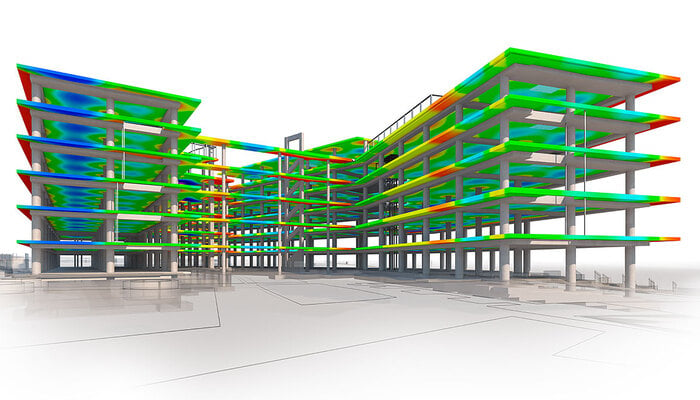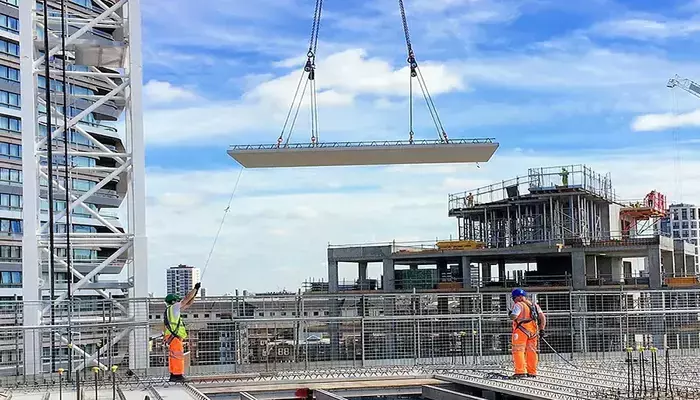How BIM Can Boost Salaries for Mid-Level Civil Engineers

Table of Contents
“What next?”
This is a question most mid-level civil engineers ask themselves. Once they complete four to five years in the profession, there comes a point when most civil engineers experience career stagnancy. There can be multiple reasons behind this. From limited work opportunities and a busy routine to inadequate knowledge about future industry trends. For civil engineers going through this phase or just want to improve their future career prospects, a career in Building Information Modelling (BIM) can be a lucrative opportunity.
What is BIM?

BIM is a process that operates primarily through creating a 3D model representing the architectural and structural components of a building. This 3D representation is then enriched with various information about the structure. This comprehensive 3D model has all the information about a building, such as its geometry, materiality, energy requirement, plumbing, electrical, and HVAC (heating, ventilation, and air conditioning). This not only helps in the pre-construction phase but also helps analyse a building’s performance during the course of its life cycle. Civil 3D, Tekla Structures, Revit, InfraWorks, and MicroStation are some of the most widely used software for civil engineers.
How is BIM Relevant in Civil Engineering

BIM is one of the most advanced technologies in the design and construction industry. Even though it is commonly associated with architecture and modelling, it is a vastly useful tool for civil engineers. From analysing construction sites to structural analysis and from quantity estimation to sustainable planning, BIM makes all of these easy. That’s why BIM enhances how infrastructure projects are planned, constructed, and managed. Let’s look at how BIM is shaping the future of civil engineers.
1. What is the Role of BIM in Modern Civil Engineering Projects?
Today, the demand for building construction and infrastructure projects is on the rise. To keep up with this increasing demand, it is essential that modern-day civil engineering projects adopt new technologies such as BIM. It can help in efficiently speeding up the construction process while maintaining excellent quality and precision at work.
2. How is BIM Beneficial in Civil Engineering?
BIM models operate in real-time, allowing civil engineers to collaborate with other project stakeholders efficiently. It also improves project management and scheduling, helping avoid confusion and ensuring all team members are on the same page. Additionally, BIM aids in the iterative design process, enabling professionals to ideate and test their ideas before finalising. This ensures that all construction decisions are governed by detailed analysis and not just mere assumptions.
BIM can also be used to generate an accurate Bill of Quantities (BOQ) to confirm that a project is completed well within the estimated budget. Furthermore, civil engineers can simulate many scenarios in BIM models to optimise a project for sustainability, performance, operations, and maintenance. This reduces any clashes and discrepancies before the construction work begins.
BIM Engineer Salary v/s Traditional Civil Engineer Salary

The salary of a civil engineer can vary based on their location, scale of organisation, level of expertise, and educational qualifications. However, the table below shows a comparison of the average annual salaries of BIM engineers v/s traditional civil engineers.
| Years of Experience | Traditional Civil Engineer Salary (INR) | BIM Engineer Salary (INR) |
| 1-3 | 2,50,000 | 3,50,000 |
| 4-6 | 4,00,000 | 6,50,000 |
| 7-9 | 7,00,000 | 9,50,000 |
| 10+ | 12,50,000 | 15,00,000 |
How Can Adopting BIM Boost Your Salary as a Civil Engineer?
As seen in the table above, the average BIM engineer salary is better than a traditional civil engineer salary. A key reason for the improved payscale is that BIM is future-relevant. It makes building construction simpler, smarter, and stronger, helping design the buildings of tomorrow. Consequently, everyone from small-scale firms to large-scale construction companies is adopting BIM in their construction processes. Therefore, the demand for civil engineers who are skilled in BIM software and tools is rapidly increasing. Recruiters are willing to pay competitive salaries to BIM engineers because they understand that BIM can help their organisation grow exponentially. The demand is even higher in countries like the US, the UK, China, Singapore, South Korea, France, and more, where governments are making the use of BIM mandatory in all future construction projects. All in all, BIM adoption is a win-win situation, letting the Architecture, Engineering, and Construction (AEC) community progress as a whole.
Besides Salary Growth, How is BIM Beneficial for Civil Engineers?

While an improved payscale is a solid reason for civil engineers to shift their careers towards BIM, this technology also enables civil engineers to be better professionals and futureproof their skill sets. Let’s look at how BIM is proving to be lucrative for civil engineers.
1. Improved Design Visualisation
The most important benefit of BIM for civil engineers is that it aids in the comprehensive three-dimensional visualisation of a project. Professionals can view and analyse a design by testing the model under various conditions to ensure that the final outcome is the best possible solution they can create.
2. Efficient Team Collaboration
Using BIM models, civil engineers can work alongside global teams in real time. This ensures that all project stakeholders are working on the most recent version of a design and proposing the most relevant solutions for their area of work. From architects to mechanical, electrical and plumbing (MEP) professionals, it helps in effective team coordination. This allows construction projects to work faster and more efficiently.
3. Cost and Resource Optimisation
BIM software can generate accurate BOQs, based on which civil engineers can share realistic budgets with their clients. Additionally, this BOQ can be used for specifying and quantifying material requirements, thus enabling resource optimisation. It can also help in saving the extra money spent on material transportation and storage.
4. Enhanced Decision-Making
Civil engineers can use BIM to study 3D models under multiple scenarios through simulations. This helps understand the building's performance against seismic loads, wind loads, and changes in future environmental conditions. This study can allow civil engineers to propose the most well-suited solution for a project that can stand the test of time.
5. Early Clash Detection
BIM allows civil engineers to detect potential clashes between building systems and utility services that may occur over time in the design process. This helps in the timely rectification of a design, thus avoiding delays and saving the cost of excessive repairs.
6. Energy-Efficiency
Using BIM enables civil engineers to map the energy consumption of a building, which can be used to optimise its overall performance. Professionals can consider employing renewable energy sources in the project to reduce the demand for energy but also consider using passive strategies based on BIM analysis. This can help in reducing the carbon footprint of the project and reduce its overall energy consumption as well.
7. Facility Management
The benefits of BIM for civil engineers are not just restricted to the construction phase, but also extend throughout a building’s lifespan. BIM can be used to study the performance of various building components and suggest repair and maintenance activities. This can significantly help avoid accidents and fatalities caused due to structural malfunctions.
How Can a Mid-Level Civil Engineer Make a Career in BIM?

Now is the best time for civil engineers to make a career in BIM. The BIM industry is booming. According to research, the growth of BIM in the construction market is projected to reach USD 11 billion by 2030. Let’s look at how civil engineers can learn BIM and lay the foundation for a shining career.
1. Academic and Online Courses
Civil engineers can learn BIM by enrolling in various programs offered by leading universities and institutions. The average cost of a postgraduate program in BIM can be anywhere between INR 10,00,000 to INR 15,00,000. However, this approach is more suited for professionals who are new to the field or those who can afford to take a break of 1-2 years for academic learning.
For mid-level civil engineers, online self-paced courses are more advantageous. They offer the flexibility of learning while still being on the job combined with world-class learning. You can look up BIM courses on platforms like Novatr, Coursera, Udemy, and LinkedIn Learning to select one that best suits your needs. We recommend evaluating the course through the depth of its curriculum, duration, fee, mentors, practical learning, and placement opportunities. The average cost of an online BIM course can range anywhere between INR 10,000 to INR 5,00,000, depending on course length, scope and more. Typically, the Return on Investment (ROI) in such courses is pretty high, and professionals can easily compensate for their investment with a considerable BIM engineer salary.
2. Professional and Field Training
Mid-level civil engineers often have a very tight schedule and are almost always on construction sites. For such professionals, it is highly recommended that they be a part of projects that help them learn BIM through practical learning. Since practice-based learning is the best way to grasp technology, it will be easier for civil engineers to understand the industry applications of BIM. To supplement this knowledge, professionals can check out free online resources such as videos and research papers to learn the theory of BIM. Additionally, they can register for BIM-related conferences to keep up with the latest developments in the industry.
7. What are the Various Careers in BIM for Civil Engineers with Salary?
A mid-level civil engineer with appropriate knowledge of BIM can take up various roles in the industry. Let’s look at the 3 prevalent careers in BIM for civil engineers.
1. Construction Manager
The scope of work of a BIM-proficient civil engineer working as a construction manager involves planning and overseeing construction projects. In this field, BIM maps project progress, cost estimation, and scheduling. On average, a civil engineer's salary in a construction management role can range from $60,000 to $120,000 annually.
2. Facility Manager
The role of a facility manager entails studying, maintaining, and managing building construction and infrastructure projects post-construction. They use BIM to track building performance and suggest repairs as and when required. The average annual salary of a facility manager in the United States can range from $50,000 to $100,000.
3. Structural Specialist
BIM engineers who specialise in using BIM tools to work on the design, analysis, and construction of structures work in structural engineering and can become structural specialists. They work on areas like structural analysis, reviewing technical specifications for structural components, and conducting inspections to assess the structural integrity of existing structures and upcoming construction projects. On average, a BIM engineer's salary working as a structural specialist can range between $65,000 to $130,000 in a year.
In Conclusion
Upskilling in BIM is the smartest investment that civil engineers can make for their careers. This is because BIM is not just a tool, it is a revolution that’s redefining the future of work in the AEC industry. Countries such as the US, UK, UAE, India, and Australia are promoting the use of BIM in public infrastructure projects. So, it is only a matter of time before this mandate comes down to small-scale projects as well. Thus, by learning BIM, civil engineers can secure their future, earn well, and craft a meaningful niche for themselves.
If you wish to learn BIM and stay future-relevant, check out the BIM Professional Course for Civil Engineers offered by Novatr.


 Thanks for connecting!
Thanks for connecting!



.png)





